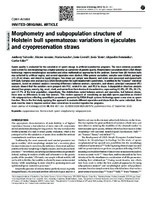Mostrar el registro sencillo del ítem
Morphometry and subpopulation structure of Holstein bull spermatozoa: Variations in ejaculates and cryopreservation straws
| dc.contributor.author | Arenán, Héctor | |
| dc.contributor.author | Sancho, María | |
| dc.contributor.author | Contell, Jesús | |
| dc.contributor.author | Yániz, Jesús | |
| dc.contributor.author | Fernández, Alejandro | |
| dc.contributor.author | Soler, Carles | |
| dc.contributor.author | Valverde-Abarca, Anthony | |
| dc.date.accessioned | 2018-08-27T20:28:44Z | |
| dc.date.available | 2018-08-27T20:28:44Z | |
| dc.date.issued | 2016 | |
| dc.identifier | https://www.ncbi.nlm.nih.gov/pmc/articles/PMC5109875/ | es |
| dc.identifier.citation | Valverde, A., Arenán, H., Sancho, M., Contell, J., Yániz, J., Fernández, A., & Soler, C. (2016). Morphometry and subpopulation structure of Holstein bull spermatozoa: variations in ejaculates and cryopreservation straws. Asian Journal of Andrology, 18, 851–857. | es |
| dc.identifier.uri | https://hdl.handle.net/2238/9960 | |
| dc.description | Artículo científico | es |
| dc.description.abstract | Sperm quality is evaluated for the calculation of sperm dosage in artificial reproductive programs. The most common parameter used is motility, but morphology has a higher potential as a predictor of genetic quality. Morphometry calculations from CASA‑Morph technology improve morphological evaluation and allow mathematical approaches to the problem. Semen from 28 Holstein bulls was collected by artificial vagina, and several ejaculates were studied. After general evaluation, samples were diluted, packaged in 0.25 ml straws, and stored in liquid nitrogen. Two straws per sample were thawed, and slides were processed and stained with Diff‑Quik. Samples were analyzed by a CASA‑Morph system for eight morphometric parameters. In addition to the “classical” statistical approach, based on variance analysis (revealing differences between animals, ejaculates, and straws), principal component (PC) analysis showed that the variables were grouped into PC1, related to size, and PC2 to shape. Subpopulation structure analysis showed four groups, namely, big, small, short, and narrow from their dominant characteristics, representing 31.0%, 27.3%, 24.1%, and 17.7% of the total population, respectively. The distributions varied between animals and ejaculates, but between straws, there were no differences in only four animals. This modern approach of considering an ejaculate sperm population as divided into subpopulations reflecting quantifiable parameters generated by CASA‑Morph systems technology opens a new view on sperm function. This is the first study applying this approach to evaluate different ejaculates and straws from the same individual. More work must be done to improve seminal dose calculations in assisted reproductive programs. | es |
| dc.description.sponsorship | Instituto Tecnológico de Costa Rica. Escuela de Agronomía. Sede San Carlos. | es |
| dc.language.iso | eng | es |
| dc.relation.hasversion | 10.4103/1008-682X.187579 | es |
| dc.rights | acceso abierto | es |
| dc.source | Asian Journal of Andrology | es |
| dc.subject | Reproducción | es |
| dc.subject | Morfología | es |
| dc.subject | Mortalidad | es |
| dc.subject | Genética | es |
| dc.subject | Research Subject Categories::FORESTRY, AGRICULTURAL SCIENCES and LANDSCAPE PLANNING::Plant production::Agronomy | es |
| dc.title | Morphometry and subpopulation structure of Holstein bull spermatozoa: Variations in ejaculates and cryopreservation straws | es |
| dc.type | artículo original | es |
Ficheros en el ítem
Este ítem aparece en la(s) siguiente(s) colección(ones)
-
Artículos [26]


